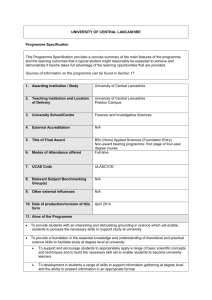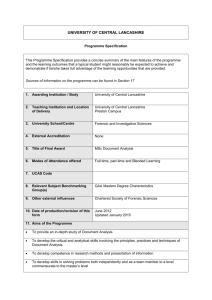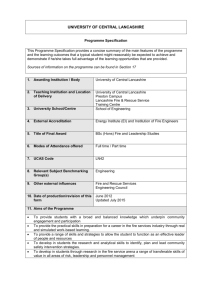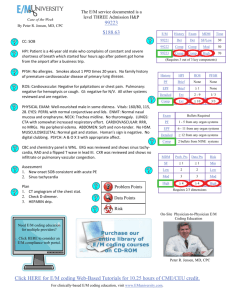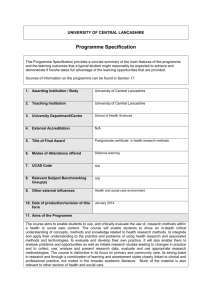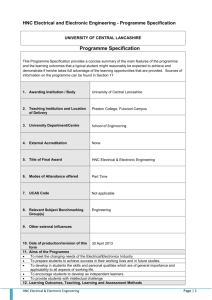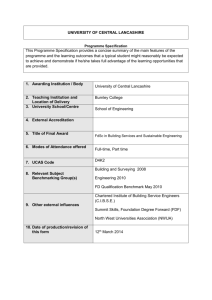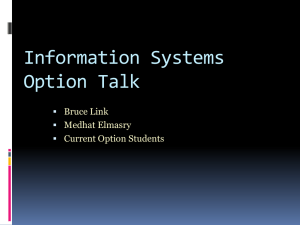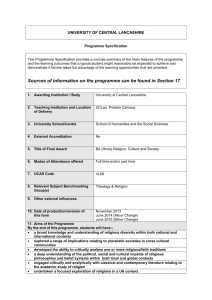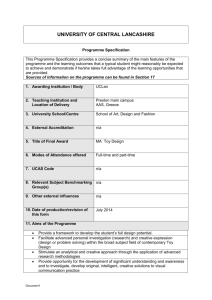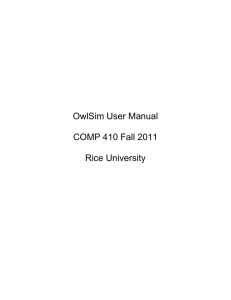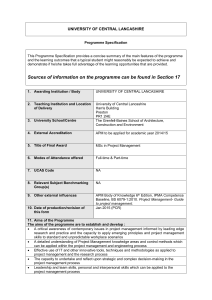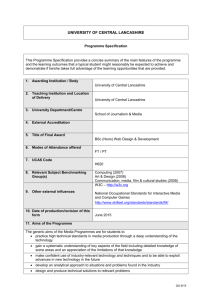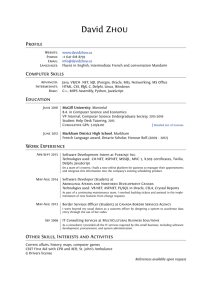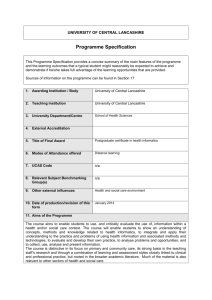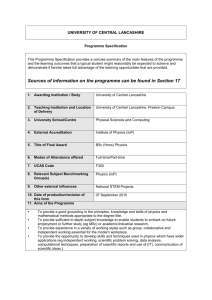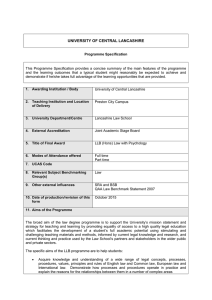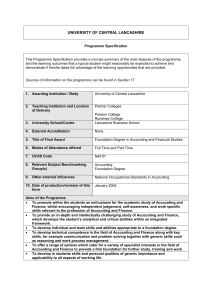FdSc Fire Safety Engineering (July 2015)
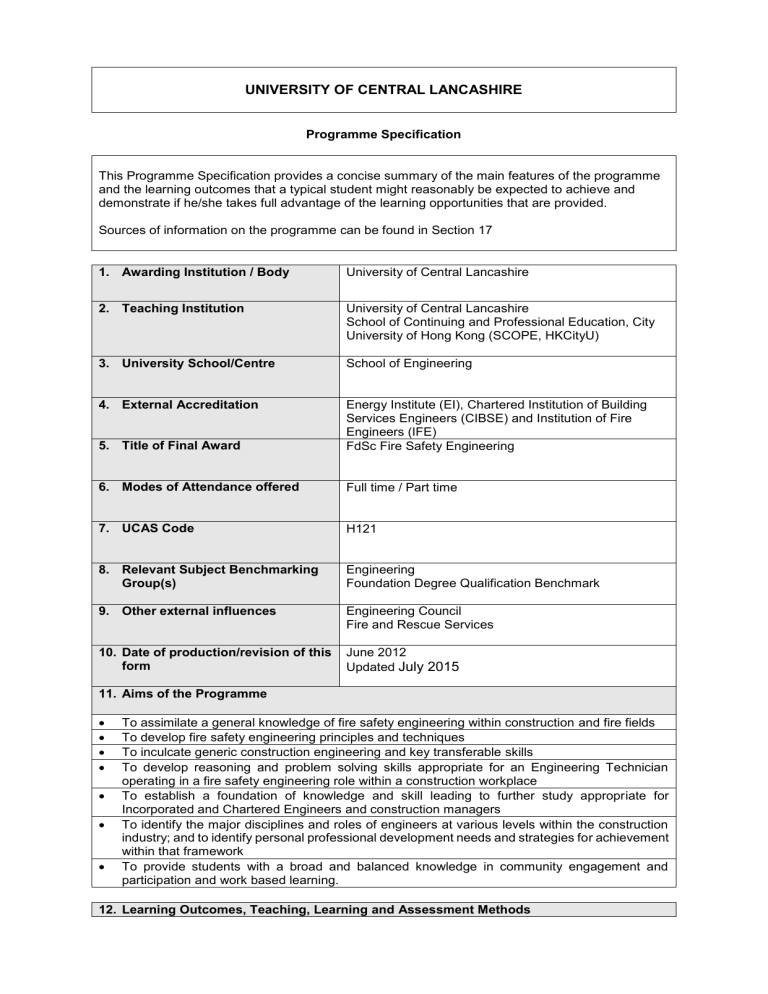
UNIVERSITY OF CENTRAL LANCASHIRE
Programme Specification
This Programme Specification provides a concise summary of the main features of the programme and the learning outcomes that a typical student might reasonably be expected to achieve and demonstrate if he/she takes full advantage of the learning opportunities that are provided.
Sources of information on the programme can be found in Section 17
1. Awarding Institution / Body University of Central Lancashire
2. Teaching Institution
3. University School/Centre
4. External Accreditation
5. Title of Final Award
6. Modes of Attendance offered
7. UCAS Code
8. Relevant Subject Benchmarking
Group(s)
9. Other external influences
University of Central Lancashire
School of Continuing and Professional Education, City
University of Hong Kong (SCOPE, HKCityU)
School of Engineering
Energy Institute (EI), Chartered Institution of Building
Services Engineers (CIBSE) and Institution of Fire
Engineers (IFE)
FdSc Fire Safety Engineering
Full time / Part time
H121
Engineering
Foundation Degree Qualification Benchmark
Engineering Council
Fire and Rescue Services
10. Date of production/revision of this form
June 2012
Updated
July 2015
11. Aims of the Programme
To assimilate a general knowledge of fire safety engineering within construction and fire fields
To develop fire safety engineering principles and techniques
To inculcate generic construction engineering and key transferable skills
To develop reasoning and problem solving skills appropriate for an Engineering Technician operating in a fire safety engineering role within a construction workplace
To establish a foundation of knowledge and skill leading to further study appropriate for
Incorporated and Chartered Engineers and construction managers
To identify the major disciplines and roles of engineers at various levels within the construction industry; and to identify personal professional development needs and strategies for achievement within that framework
To provide students with a broad and balanced knowledge in community engagement and participation and work based learning.
12. Learning Outcomes, Teaching, Learning and Assessment Methods
A. Knowledge and Understanding
A1. Demonstrate the ability to appraise the design, construction and performance of structures and their safety systems
A2. Demonstrate the ability to assess the fire safety needs of buildings in a real or simulated workplace environment
A3. Demonstrate knowledge of social, environmental, legal and management issues impacting upon fire safety engineering practice
A4. Demonstrate knowledge of fundamental engineering science and mathematical analysis
Teaching and Learning Methods
Lectures, seminars, tutorials, workshops, directed reading, problem solving and case studies
Assessment methods
Assignment and design reports, portfolio, formal examinations and presentations and group projects
B. Subject-specific skills
B1. Demonstrate the ability to apply accepted theory, tools and techniques of fire safety engineering in a real of simulated workplace
B2. Demonstrate occupational competence in a range of work skills within the context of the construction and fire industries
B3. Demonstrate the capacity to work with stakeholders across the construction industry
B4. Demonstrate management of an engineering function
Teaching and Learning Methods
Lectures, seminars, tutorials, workshops, directed reading, problem solving and case studies
Assessment methods
Assignment and design reports, portfolio, formal examinations and presentations and group projects
C. Thinking Skills
C1. Demonstrate reasoning skills within the context of fire safety engineering in order to identify suitable methods, materials or components
C2. Demonstrate the ability to solve problems by engineering solutions.
Teaching and Learning Methods
Lectures, seminars, tutorials, workshops, directed reading, problem solving and case studies
Assessment methods
Assignment and design reports, portfolio, formal examinations and presentations and group projects
D. Other skills relevant to employability and personal development
D1. Demonstrate the use of communication skills in oral and written form in a variety of real or simulated work related situations
D2. Demonstrate the ability to use information resources and technology in order that information is effectively managed and presented
Teaching and Learning Methods
Lectures, seminars, tutorials, workshops, directed reading, problem solving and case studies
Assessment methods
Assignment and design reports, portfolio, formal examinations and presentations and group projects
13. Programme Structures*
Level Module
Code
Module Title
Level 5 FV2001
FV2003
FV2004
FV2207
FV2501
FV2900
Fluid Dynamics of Fire
Fire and the Built Environment
Fire Safety Management and
Legislation
Structures, Materials and Fire
Community Fire Safety Strategies
Fire Science Project
Credit rating
20
20
20
20
20
20
14. Awards and Credits*
Foundation Degree in Fire
Safety Engineering
Requires 240 credits at level 4 or above including a minimum of 100 at Level 5 or above.
APM ≥ 60% - Foundation
Degree with Merit
APM ≥ 70% Foundation
Degree with Distinction
Level 4 FV1001
FV1101
FV1201
FV1207
FV1301
FV1501
Introduction To Combustion and Fire
Safety and Fire Law
Energy Transfer and
Thermodynamics
Buildings, Materials and Fire
Introduction to Engineering Analysis
Community Fire Safety
20
10
20
20
20
20
10
Foundation Certificate in
Fire Safety Engineering
Requires 120 credits at
Level 4 or above.
FV1502 Skills for Science and Engineering
15. Personal Development Planning
Opportunities for reflective learning occur throughout the course, in particular in modules assessed by portfolio. The workplace modules enable students to develop generic and key transferable skills by engaging in work or simulated work practice, discussing and reflecting upon the experience and using a range of tools to report effectively on the experience within their portfolio. The nature and relations between the common engineering and construction professions is examined along with the level of engineering expertise associated with particular roles; and hence the student’s current and possible future role and means to achieve competence for that role.
16. Admissions criteria
Programme Specifications include minimum entry requirements, including academic qualifications, together with appropriate experience and skills required for entry to study.
These criteria may be expressed as a range rather than a specific grade. Amendments to entry requirements may have been made after these documents were published and you should consult the University’s website for the most up to date information.
Students will be informed of their personal minimum entry criteria in their offer letter.
Applicants will be normally be required to have, one of:
DDE at A2, BTEC ND MPP. IB 24P, Pass Access Course.
In addition applicants will be required to have Maths and English GCSE at Grade C or equivalent.
Applicants will be required to have a minimum level of proficiency in English Language equivalent to
IELTS grade 6 with no subscore lower than 5.5
Applications from individuals with non-standard qualifications, relevant work or life experience and who can demonstrate the ability to cope with and benefit from degree-level studies are welcome. If candidates have not studied recently they may be required to undertake an Access programme.
APL/APEL will be assessed through standard University procedures.
Please consult the UCLAN admissions department for the most up to date requirements.
17. Key sources of information about the programme
University web site ( www.uclan.ac.uk
)
UCAS web site ( www.ucas.ac.uk
)
School website ( www.uclan.ac.uk/forensic )
Course Leader
Admissions tutor
18. Curriculum Skills Map
Please tick in the relevant boxes where individual Programme Learning Outcomes are being assessed
Programme Learning Outcomes
Module
Level Code Module Title
FV2001 Fluid Dynamics of Fire
Core (C) or
Option
(O)
COMP
COMP
COMP
Knowledge and understanding Subject-specific Skills Thinking Skills
A1 A2 A3 A4 B1 B2 B3 B4
C1
C2
FV2003 Fire and Built Environment
FV2004 Fire Safety Management and
Legislation
FV2207 Structures, Materials and Fire
COMP
FV2501 Community Fire Safety
Strategies
FV2900 Fire Science Project
COMP
C
FV1001 Introduction to Combustion and
Fire
FV1101 Safety and Fire Law
FV1201 Energy Transfer and
Thermodynamics
FV1207 Buildings, Materials and Fire
COMP
COMP
COMP
COMP
FV1301 Introduction to Engineering
Analysis
FV1501 Community Fire Safety
COMP
COMP
FV1502 Skills for Science and
Engineering
COMP
Note: Mapping to other external frameworks, e.g. professional/statutory bodies, will be included within Student Course Handbooks
Other skills relevant to employability and personal development
D1
D2
